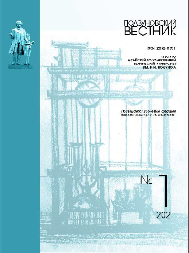STRUCTURAL-PHASE STATE OF HIGH-ENTROPY Al–Co–Cr–Fe–Ni ALLOY OBTAINED BY WIRE-ARC ADDITIVE TECHNOLOGY
doi: 10.25712/ASTU.2072-8921.2021.01.020
Keywords:
high-entropy alloy Al–Co–Cr–Fe–Ni, wire-arc additive manufacturing, structure, phase compositionAbstract
A description of the method of forming a high-entropy alloy of the composition Al–Co–Cr–Fe–Ni using wire-arc additive production is given. The modes and operating parameters of the surfacing complex, the trajectory of the deposition of layers on the substrate made of St20 steel are presented. The resulting alloy has the following elemental composition (wt %): 15,64 Al; 7,78 Co; 8,87 Cr; 22,31 Fe; 44,57 Ni with 0,53 Si impurities; 0,18 Cu; 0,098 Ti. It has been shown by the methods of modern physical materials science that the sizes of dendrites of the obtained HEA vary within 40–80 microns. Inclusions of the second phase were revealed along the boundaries of dendritic grains and in the volume. It has been established by mapping methods that the grain boundaries are enriched with chromium and iron atoms, the grain volume is enriched with nickel and aluminum atoms, and cobalt is uniformly distributed in the alloy. The phase composition of the alloy, AlNi and Al2FeCo, was determined using a qualitative analysis of diffraction patterns.
Downloads
Published
How to Cite
Issue
Section
License
Copyright (c) 2021 Kirill A. Osintsev, Victor E. Gromov, Sergey V. Konovalov, Irina A. Panchenko, Ekaterina S. Vashchuk

This work is licensed under a Creative Commons Attribution 4.0 International License.















 .
. This work is licensed under a
This work is licensed under a 
